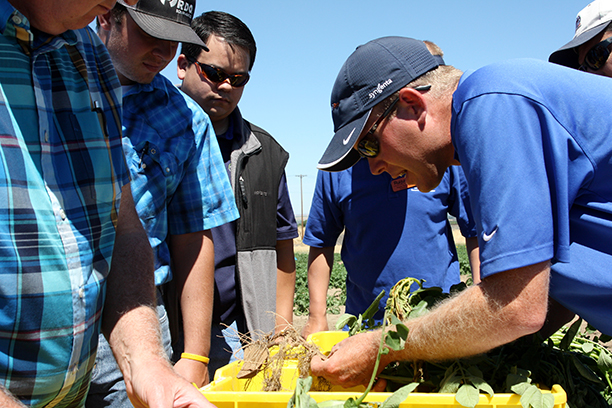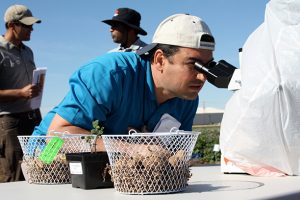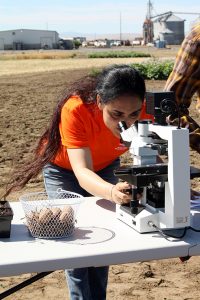Story and photos by Denise Keller, Editor
With several key soil fumigants subject to unreliable supply chains and increasing use restrictions, the potato industry continues to investigate alternative methods to control soil-borne pathogens. This includes the development of varieties with resistance to pests and diseases. Researchers at the Oregon State University (OSU) Potato Field Day, held June 21 at OSU’s Hermiston Agricultural Research and Extension Center (HAREC), explained how they’re using new technology to accelerate the process of breeding resistant varieties.
Finding Sources of Resistance
Ryan Graebner, a PhD candidate in potato breeding and genetics, gave an overview of the work being done to develop potato varieties with resistance to the Columbia root-knot nematode and Verticillium dahliae.
Both soil-borne pathogens can create considerable challenges for potato growers in the Columbia Basin. Columbia root-knot nematodes establish feeding sites at potato roots and tubers, stunting the plant’s growth and causing tuber quality defects. Verticillium dahliae is the fungus that causes Verticillium wilt, which can lead to early death of the plant.
OSU researchers are trying to find new sources of resistance to the pathogens and bring the resistance genes into the breeding program. Doing so could enable the industry to shift away from the current regime of chemical control to a system that emphasizes soil health, according to Graebner.
“If we can make this all work, the payoffs are huge,” he said, noting that development of resistant varieties can reduce input costs and improve reliability of control. “There’s no guarantee that the current methods of chemical control are going to be an option forever. Being able to move away from that and having something that’s always going to be safe, effective and available, would give a lot of stability to controlling these pathogens.”
While some commercial potato cultivars are moderately resistant to Verticillium dahliae, there’s room for improvement, Graebner said. So far, researchers have found partial resistance that might be able to strengthen resistance already present in breeding programs. As for the Columbia root-knot nematode, researchers have identified genes with strong resistance in wild potato species that may complement previously identified resistance genes. Next steps include making crosses through traditional breeding to move the genes from wild species into released potato varieties.
“It can take 20 years to move resistance genes from a wild species into a commercial variety,” Graebner said. “That’s kind of a dreary outlook, but somebody needs to start it so we can lay the groundwork for the future.”
Speeding up the Process
Sapinder Bali, a postdoctoral scholar in potato breeding and genetics, detailed how she is using molecular biology-based knowledge to help breeders develop varieties resistant to the Columbia root-knot nematode.
She said the new trend in plant breeding is marker-assisted selection, which entails developing DNA-based markers linked to a specific trait and making selections based on those markers. Researchers can grow the plants in a greenhouse, sample leaves, isolate the DNA, and run markers to determine which of them harbor resistance genes. This technology reduces the work required in the field, provides more accurate results and can speed up the breeding process by four or five years, according to Bali.
Solanum bulbocastanum, a wild relative of potato from Mexico, has been found to harbor genetic resistance to the Columbia root-knot nematode. Breeders have transferred this resistance from the wild species into a potato breeding clone. Now they need to transfer this resistance into a commercially acceptable variety. Currently, Bali is trying to develop markers linked to the resistance trait and gain knowledge about the trait mechanism. She has some candidate genes that may be involved in the resistance, she said, but she needs to validate them.
“It’s not just about resistance. It’s combining the resistance with the best tuber quality and yield we can get for the Pacific Northwest region,” Bali explains. “Breeding is really a slow process. But when it works, it works wonders. Breeding is a process of developing improved varieties to help growers fight pests and other problems in the crop. Once we have a good variety with resistance and acceptable tuber traits, that’s really going to benefit the growers.”
Managing Nematodes Now
Potato breeders are making strides toward developing cultivars with resistance to Columbia root-knot nematodes. In the meantime, however, OSU’s Russ Ingham gave field day attendees some nematode control recommendations to help prepare for the 2018 growing season.
Ingham mentioned that DuPont’s Vydate insecticide/nematicide should be available for the 2018 season, but supplies are likely to be limited. Vydate has been in short supply since production was suspended after a fatal accident at the company’s former production plant in 2014. This winter, DuPont announced that it had secured a new supply source for the product.
Telone has also been in short supply due to a shortage in raw materials and demands from other markets. Fall allocations look similar to last year, but delivery timings may play a factor in overall usable volume for this fall. More Telone will be arriving in November and December than in previous years, Ingham said, which may increase the availability for spring applications although the total volume that will be available in the spring is unknown.
Telone availability for the 2018 crop is likely to be less than demand again, Ingham predicted. Growers may want to take advantage of the 2(ee) that recommends rates as low as 11 gallons per acre for nematode suppression to extend the available supply. As Vydate reenters the market, following a reduced rate of Telone with a standard Vydate program should provide an excellent option, he said.
Ingham suggested that growers confirm the amount of Telone and Vydate that would be available to them and plan management alternatives to account for shortages. He also offered the following recommendations:
- Use a reduced rate of Telone with a full rate of metam sodium or Mocap.
- Make sure conditions are optimal for Telone, considering shank spacing, temperature, moisture and seal.
- Shank in metam sodium at the full rate with Mocap broadcast pre-plant incorporated or, preferably, as a tank mix.
- Manage nematodes with rotation crops and green manure crops.
- Manage the potato crop to minimize damage should infection occur.
- Sample for nematodes to determine population levels, and don’t plant potatoes into fields with high population densities.
This topic is discussed in more detail in the June 9, 2017, issue of Potato Progress.




